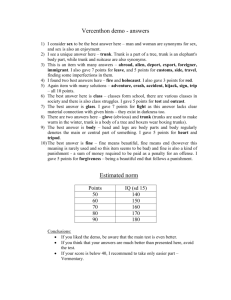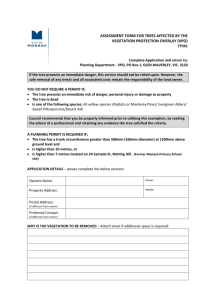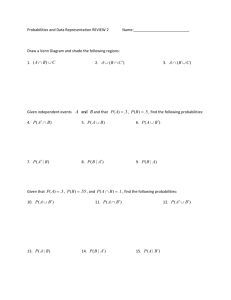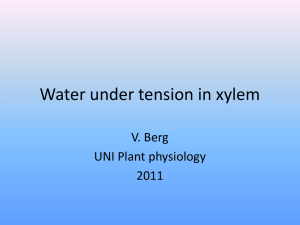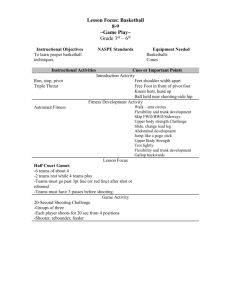R [ research
advertisement
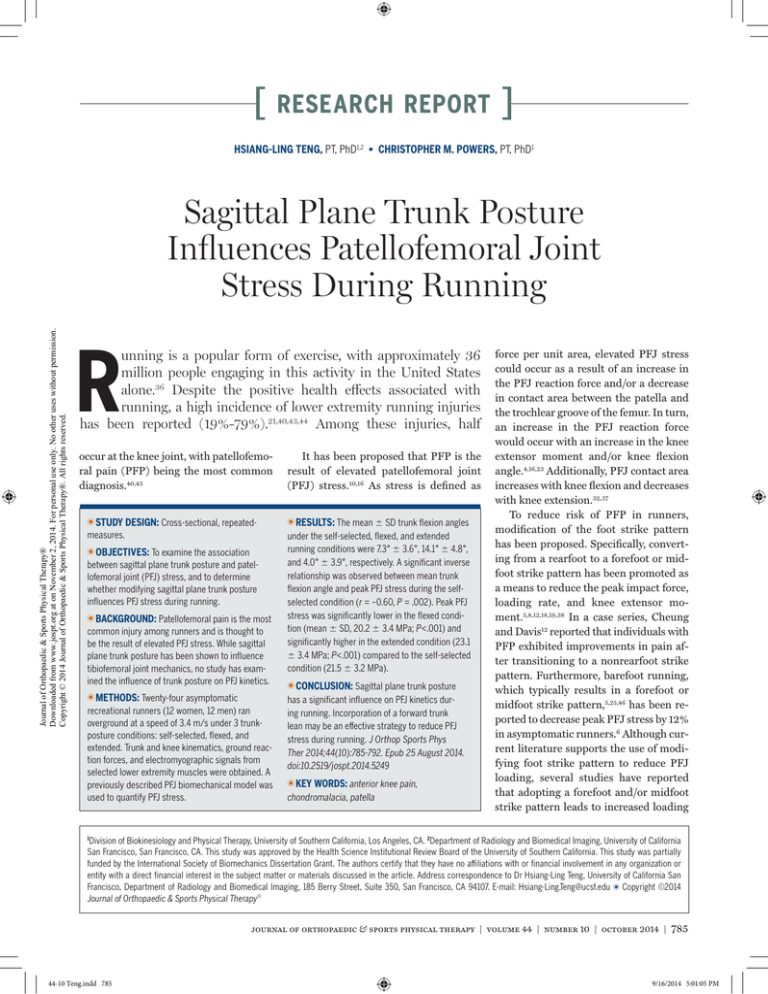
[ research report ] HSIANG-LING TENG, PT, PhD1,2 • CHRISTOPHER M. POWERS, PT, PhD1 Journal of Orthopaedic & Sports Physical Therapy® Downloaded from www.jospt.org at on November 2, 2014. For personal use only. No other uses without permission. Copyright © 2014 Journal of Orthopaedic & Sports Physical Therapy®. All rights reserved. Sagittal Plane Trunk Posture Influences Patellofemoral Joint Stress During Running R unning is a popular form of exercise, with approximately 36 million people engaging in this activity in the United States alone.36 Despite the positive health effects associated with running, a high incidence of lower extremity running injuries has been reported (19%-79%).21,40,43,44 Among these injuries, half occur at the knee joint, with patellofemoral pain (PFP) being the most common diagnosis.40,43 TTSTUDY DESIGN: Cross-sectional, repeatedmeasures. TTOBJECTIVES: To examine the association between sagittal plane trunk posture and patellofemoral joint (PFJ) stress, and to determine whether modifying sagittal plane trunk posture influences PFJ stress during running. TTBACKGROUND: Patellofemoral pain is the most common injury among runners and is thought to be the result of elevated PFJ stress. While sagittal plane trunk posture has been shown to influence tibiofemoral joint mechanics, no study has examined the influence of trunk posture on PFJ kinetics. TTMETHODS: Twenty-four asymptomatic recreational runners (12 women, 12 men) ran overground at a speed of 3.4 m/s under 3 trunkposture conditions: self-selected, flexed, and extended. Trunk and knee kinematics, ground reaction forces, and electromyographic signals from selected lower extremity muscles were obtained. A previously described PFJ biomechanical model was used to quantify PFJ stress. It has been proposed that PFP is the result of elevated patellofemoral joint (PFJ) stress.10,16 As stress is defined as TTRESULTS: The mean SD trunk flexion angles under the self-selected, flexed, and extended running conditions were 7.3° 3.6°, 14.1° 4.8°, and 4.0° 3.9°, respectively. A significant inverse relationship was observed between mean trunk flexion angle and peak PFJ stress during the selfselected condition (r = –0.60, P = .002). Peak PFJ stress was significantly lower in the flexed condition (mean SD, 20.2 3.4 MPa; P<.001) and significantly higher in the extended condition (23.1 3.4 MPa; P<.001) compared to the self-selected condition (21.5 3.2 MPa). TTCONCLUSION: Sagittal plane trunk posture has a significant influence on PFJ kinetics during running. Incorporation of a forward trunk lean may be an effective strategy to reduce PFJ stress during running. J Orthop Sports Phys Ther 2014;44(10):785-792. Epub 25 August 2014. doi:10.2519/jospt.2014.5249 TTKEY WORDS: anterior knee pain, chondromalacia, patella force per unit area, elevated PFJ stress could occur as a result of an increase in the PFJ reaction force and/or a decrease in contact area between the patella and the trochlear groove of the femur. In turn, an increase in the PFJ reaction force would occur with an increase in the knee extensor moment and/or knee flexion angle.4,16,23 Additionally, PFJ contact area increases with knee flexion and decreases with knee extension.32,37 To reduce risk of PFP in runners, modification of the foot strike pattern has been proposed. Specifically, converting from a rearfoot to a forefoot or midfoot strike pattern has been promoted as a means to reduce the peak impact force, loading rate, and knee extensor moment.5,8,12,18,19,38 In a case series, Cheung and Davis12 reported that individuals with PFP exhibited improvements in pain after transitioning to a nonrearfoot strike pattern. Furthermore, barefoot running, which typically results in a forefoot or midfoot strike pattern,5,25,46 has been reported to decrease peak PFJ stress by 12% in asymptomatic runners.6 Although current literature supports the use of modifying foot strike pattern to reduce PFJ loading, several studies have reported that adopting a forefoot and/or midfoot strike pattern leads to increased loading Division of Biokinesiology and Physical Therapy, University of Southern California, Los Angeles, CA. 2Department of Radiology and Biomedical Imaging, University of California San Francisco, San Francisco, CA. This study was approved by the Health Science Institutional Review Board of the University of Southern California. This study was partially funded by the International Society of Biomechanics Dissertation Grant. The authors certify that they have no affiliations with or financial involvement in any organization or entity with a direct financial interest in the subject matter or materials discussed in the article. Address correspondence to Dr Hsiang-Ling Teng, University of California San Francisco, Department of Radiology and Biomedical Imaging, 185 Berry Street, Suite 350, San Francisco, CA 94107. E-mail: Hsiang-Ling.Teng@ucsf.edu t Copyright ©2014 Journal of Orthopaedic & Sports Physical Therapy® 1 journal of orthopaedic & sports physical therapy | volume 44 | number 10 | october 2014 | 785 44-10 Teng.indd 785 9/16/2014 5:01:05 PM [ TABLE 1 Age, y Height, m research report Participant Demographics* Men (n = 12) Women (n = 12) 28.1 7.2 26.5 6.4 1.74 0.08 1.66 0.08 Weight, kg 70.5 7.0 62.7 6.6 Running distance, km/wk 19.3 10.1 22.9 11.1 Journal of Orthopaedic & Sports Physical Therapy® Downloaded from www.jospt.org at on November 2, 2014. For personal use only. No other uses without permission. Copyright © 2014 Journal of Orthopaedic & Sports Physical Therapy®. All rights reserved. *Values are mean SD. at the ankle plantar flexors.2,5,8,19,31,35,46 Recent studies suggest that sagittal plane trunk posture may be associated with tibiofemoral joint biomechanics during weight-bearing activities. For example, a forward trunk lean posture has been found to be associated with lower knee extensor moments during walking, stair ascent, and single-leg-hop landing.3,24,30 Based on these findings, modifying sagittal plane trunk posture may provide an alternative means to reduce PFJ stress during running. Using a previously described biomechanical PFJ model,9,10,13,20 the purpose of the current study was 3-fold. First, we sought to examine the association between sagittal plane trunk posture and PFJ stress using a self-selected trunk posture. Second, we evaluated the effects of modifying sagittal plane trunk posture on PFJ stress during running. A tertiary purpose of this study was to identify patellofemoral and tibiofemoral kinematics and kinetics that may explain the changes in PFJ stress while running with different trunk postures. Based on existing literature evaluating the influence of trunk posture on tibiofemoral joint kinetics and kinematics, we hypothesized that an individual’s self-selected trunk flexion angle would be inversely associated with the peak PFJ stress during the stance phase of running. We also hypothesized that, compared to a self-selected trunk posture, a more flexed trunk posture would result in a decrease in peak PFJ stress during running and, conversely, a more extended trunk posture would result in an increase in peak PFJ stress. Understanding the association between sagittal plane trunk posture and PFJ stress during running may advance the understanding of the etiology of PFP in runners and facilitate the development of running techniques to reduce PFJ loading in this population. METHODS Participants T wenty-four recreational runners between the ages of 18 and 39 years participated in this study (12 men, 12 women) (TABLE 1). Participants were natural rearfoot strikers, which was verified using sagittal plane images from high-speed video (sampling rate, 125 Hz). Potential participants were excluded if they reported any of the following: (1) current lower extremity or low back pain, (2) previous history of lower extremity or low back surgery, and (3) lower extremity or low back pathology that caused pain or discomfort during running within 6 months prior to participation. Instrumentation Three-dimensional trunk and lower extremity kinematics were collected using an 11-camera motion-capture system (Qualisys AB, Göteborg, Sweden) at a sampling rate of 250 Hz. Ground reaction forces were obtained at a rate of 1500 Hz using a single force plate (Advanced Mechanical Technology, Inc, Watertown, MA). Electromyographic (EMG) signals of selected lower extremity muscles were collected at a sampling rate of 1500 Hz using a wireless EMG system (Telemyo DTS; Noraxon USA Inc, Scottsdale, AZ) and Ag/AgCl surface electrodes ] (Norotrode 20; Myotronics-Noromed, Inc, Kent, WA). The EMG system had a differential input impedance of greater than 100 MΩ, a common-mode rejection ratio greater than 100 dB, and a baseline noise of less than 1 µV root-mean-square. Marker, ground reaction force, and EMG data were collected and synchronized using motion-capture software (Track Manager Version 2.8; Qualisys AB). Procedures Data were collected at the Jacquelin Perry Musculoskeletal Biomechanics Research Laboratory at the University of Southern California. Prior to participation, participants were informed as to the objectives, procedures, and potential risks of participation in the study and provided informed consent as approved by the Health Science Institutional Review Board of the University of Southern California. Participants wore shorts, tank tops, and their personal running shoes during the evaluation. Data were obtained from each participant’s dominant leg. Leg dominance was determined by asking the participants which leg they preferred to use when kicking a ball. Participants were first instrumented with EMG electrodes. Electromyographic signals were recorded from the knee flexor muscles (medial and lateral hamstrings and gastrocnemius), and data were used to account for muscle cocontraction in our biomechanical model. The electrodes of the medial and lateral hamstrings were placed midway between the ischial tuberosity and the medial and lateral sides of the popliteal fossa, respectively.34 The electrodes for the medial and lateral gastrocnemius were placed at one third of the distance between the medial and lateral sides of the popliteal fossa, respectively, and the Achilles tendon insertion, starting from the popliteal fossa.34 Prior to placement of the EMG electrodes, the skin was shaved, abraded, and cleaned with isopropyl alcohol to reduce electrical impedance. Following electrode placement, participants were asked to warm up by jogging 786 | october 2014 | volume 44 | number 10 | journal of orthopaedic & sports physical therapy 44-10 Teng.indd 786 9/16/2014 5:01:05 PM Journal of Orthopaedic & Sports Physical Therapy® Downloaded from www.jospt.org at on November 2, 2014. For personal use only. No other uses without permission. Copyright © 2014 Journal of Orthopaedic & Sports Physical Therapy®. All rights reserved. at a self-selected speed on a treadmill for 5 minutes. After the warm-up, EMG signals were collected during a maximal voluntary isometric contraction (MVIC). The MVIC test for the medial and lateral hamstrings was performed with participants in a seated position, with their hip and knee joints at 85° and 60° of flexion, respectively.1 A strap was secured around the distal tibia just superior to the lateral malleolus to resist knee flexion. The MVIC test for the medial and lateral gastrocnemius was performed in standing. Participants stood on the tested leg and raised their heel against resistance, which was applied by a fixed bar across the shoulders. The ankle of the tested leg was at 15° of plantar flexion, and the knee was fully extended during testing.1 During each MVIC test, participants were instructed to produce a maximum effort. Three trials of a 5-second MVIC were obtained from each muscle, with a 40-second break between trials.7,39 Prior to the running trials, 21 anatomical markers (reflective 14-mm diameter) were placed on the following bony landmarks: end of second toes, first and fifth metatarsal heads, medial and lateral malleoli, medial and lateral epicondyles of femurs, greater trochanters, iliac crests, L5-S1 junction, and acromioclavicular joints. In addition, tracking marker clusters mounted on semi-rigid plastic plates were placed on the lateral surfaces of the participant’s thighs, shanks, and heel counters of the shoes. A standing calibration trial was first obtained to define the segmental coordinate systems and joint axes. After the calibration trial, anatomical markers were removed, except for those at the iliac crests, L5-S1 junction, and acromioclavicular joints. The tracking markers remained on the participant throughout the entire data-collection session. Participants were instructed to run at a controlled speed of 3.4 m/s along a 14-m runway using 3 different trunk postures: self-selected, flexed, and extended (FIGURE 1). Participants first ran using their self-selected trunk posture. During FIGURE 1. Trunk posture and lower extremity biomechanics were obtained during 3 trunk conditions: (A) extended, (B) self-selected, and (C) flexed. the flexed condition, participants were instructed to increase their trunk flexion angle within a range in which they felt comfortable when running. Similarly, participants were asked to decrease their trunk flexion angle during the extended condition. The order of the flexed and extended conditions was randomized for each participant. Practice trials were permitted to allow participants to become familiar with the running speed and various trunk postures. Five successful running trials were obtained for each trunk condition. A trial was counted as successful when the foot of the dominant leg fell within the borders of the force plate from initial contact to toe-off and the running speed was within 5% of the target velocity. Data Analysis Kinematic and kinetic data were processed and analyzed using Visual3D software (C-Motion, Inc, Germantown, MD). Marker trajectory data were lowpass filtered at 12 Hz, using a fourth-order Butterworth filter. The trunk segment was defined by markers placed bilaterally on the iliac crests and acromioclavicular joints.29 The pelvis and trunk segments were modeled as cylinders, and the lower extremity segments were modeled as frusta of cones. The local orthogonal coordinate systems of the trunk, pelvis, thigh, shank, and foot segments were derived from the standing calibration trial. Joint kinematics were calculated using a Cardan rotation sequence in an order of flexion/extension, abduction/adduction, and internal/external rotation. The trunk angle was calculated as the orientation of the trunk segment relative to the global coordinate system (global vertical axis). Knee kinematics were calculated as the motion of the shank relative to the thigh. The net knee joint moment was computed using inverse-dynamics equations. Moment data were expressed as internal (muscle) moments and normalized to each participant’s body mass. Electromyographic data were processed using MATLAB software (The MathWorks, Inc, Natick, MA). Raw EMG signals were band-pass filtered (20-450 Hz, fourth-order Butterworth),15,28 rectified, and smoothed using a 10-Hz lowpass filter (fourth-order Butterworth).11 The smoothed EMG data during the stance phase of running were normalized to the average EMG intensity recorded from the middle 3 seconds of the MVIC trials. The stance phase was defined when the vertical ground reaction force exceeded 30 N. journal of orthopaedic & sports physical therapy | volume 44 | number 10 | october 2014 | 787 44-10 Teng.indd 787 9/16/2014 5:01:06 PM Journal of Orthopaedic & Sports Physical Therapy® Downloaded from www.jospt.org at on November 2, 2014. For personal use only. No other uses without permission. Copyright © 2014 Journal of Orthopaedic & Sports Physical Therapy®. All rights reserved. [ A previously described sagittal plane biomechanical model was used to quantify PFJ reaction force and stress (FIGURE 2).9,10,13,20 Input variables for the model algorithm consisted of participant-specific kinematics and kinetics (ie, knee flexion angle and adjusted knee extensor moment) and data from previous literature (ie, PFJ contact area,32 quadriceps effective lever arm,41 and relationship between quadriceps force and PFJ reaction force42). To account for cocontraction at the knee joint during running, an estimation of knee flexor moment was required. The knee flexor moment was calculated using SIMM modeling software (Motion Analysis Corporation, Santa Rosa, CA). Using SIMM, a generic lower extremity musculoskeletal model was created with 6 musculotendon actuators: semitendinosus, semimembranosus, biceps femoris long and short heads, and medial and lateral gastrocnemius.14 The SIMM model also contained information about peak isometric muscle force, optimal muscle fiber length, pennation angle, and tendon slack length.14,17,27,45 The input variables of the SIMM model were participant-specific lower extremity kinematics and normalized EMG of the knee flexors. Lower extremity kinematic data were used to determine individual muscle tendon lengths and contraction velocities for the Hilltype muscle model in SIMM. Normalized EMG data were used to represent the level of muscle activation. Muscle activation of the semitendinosus was assumed to be the same as that of the semimembranosus, and the biceps femoris long and short heads were assumed to have the same activation.26 Torque produced by each knee flexor muscle was computed, added together, and normalized to body weight to represent knee flexor moment. To obtain a more accurate assessment of the knee extensor moment during running, the knee flexor moment calculated by the SIMM model was added to the net knee extensor moment, as quantified using the inverse-dynamics equations. This research report Net knee joint moment ] Knee flexor moment Quadriceps effective lever arm† Adjusted knee extensor moment QF Relationship between QF and PFJ RF‡ Knee flexion angle PFJ RF PFJ stress PFJ contact area* FIGURE 2. Flow chart of patellofemoral joint model. *Data from Powers et al.32 †Data from van Eijden et al.41 ‡Data from van Eijden et al.42 Abbreviations: PFJ, patellofemoral joint; QF, quadriceps forcce; RF, reaction force. resulted in an adjusted knee extensor moment that accounted for antagonist muscle activation. The first step of the model algorithm was to approximate the quadriceps force. First, the effective lever arm of the quadriceps was determined at each degree of knee flexion by fitting a nonlinear equation to the data of van Eijden et al.41 Next, the quadriceps force was calculated by dividing the adjusted knee extensor moment calculated during running by the effective lever arm. The second step of the algorithm was to estimate the PFJ reaction force. This was accomplished by multiplying the quadriceps force by a ratio reported by van Eijden et al,42 which defined the relationship between quadriceps force and PFJ reaction force as a function of knee flexion angle. The third step of the algorithm was to calculate PFJ stress. The PFJ reaction force obtained in the second step was divided by the PFJ contact area, which was determined using a secondorder polynomial curve fitted to data of Powers et al.32 The model outputs were PFJ stress and reaction force as a function of the gait cycle. The primary variables of interest were the mean trunk flexion angle and peak PFJ stress during the stance phase of running. The secondary variables of interest included PFJ reaction force, PFJ contact area, adjusted knee extensor moment, and knee flexion angle. Each of these variables was analyzed at the time of peak PFJ stress. All variables were calculated for each stride and averaged over 5 successful strides for each trunk condition. Statistical Analysis A Pearson product-moment correlation was used to examine the association between mean sagittal plane trunk posture and peak PFJ stress during the self-selected condition. Separate repeated-measures, 1-way analyses of variance (ANOVAs) were used to assess differences in each variable of interest among the 3 trunk conditions. For all significant ANOVA tests, post hoc Bonferroni tests were employed. All statistical analyses were performed using PASW Statistics software (SPSS Inc, Chicago, IL). The level of statistical significance was set at .05. RESULTS Self-Selected Trunk Posture and PFJ Stress R esults of Pearson correlation indicated a significant inverse correlation between mean trunk flexion 788 | october 2014 | volume 44 | number 10 | journal of orthopaedic & sports physical therapy 44-10 Teng.indd 788 9/16/2014 5:01:07 PM 18 20 15 10 r = –0.60 P = .002 5 0 0 2 4 6 8 10 12 14 16 25 16 20 14 PFJ Stress, MPa 25 Trunk Flexion Angle, deg Peak PFJ Stress, MPa 35 30 12 10 8 6 4 Journal of Orthopaedic & Sports Physical Therapy® Downloaded from www.jospt.org at on November 2, 2014. For personal use only. No other uses without permission. Copyright © 2014 Journal of Orthopaedic & Sports Physical Therapy®. All rights reserved. 10 5 2 0 0 0 Mean Trunk Flexion Angle, deg Women 15 10 20 30 40 50 60 70 80 90 100 0 10 20 30 40 50 60 70 80 90 100 Stance Phase, % Men Flexed FIGURE 3. Association between peak PFJ stress and mean trunk flexion angle during the selfselected trunk-posture condition. Abbreviation: PFJ, patellofemoral joint. angle and peak PFJ stress for the selfselected condition (r = –0.60, P = .002) (FIGURE 3). Trunk Kinematics Sagittal plane trunk posture during the stance phase of running for the 3 trunk conditions is presented in FIGURE 4. The ANOVA comparing average trunk flexion angle across the 3 trunk conditions indicated a significant difference across conditions (P<.001). Post hoc analysis revealed that, compared to the self-selected condition (mean SD, 7.3° 3.6°), there was a significant increase in mean trunk flexion angle during the flexed condition (14.1° 4.8°, P<.001) and a significant decrease in mean trunk flexion angle during the extended condition (4.0° 3.9°, P<.001). PFJ Biomechanics Patellofemoral joint stress during the stance phase of running for the 3 trunk conditions is presented in FIGURE 5. The ANOVA comparing peak PFJ stress across the 3 trunk conditions indicated a significant difference across conditions (P<.001) (TABLE 2). Post hoc analysis revealed that peak PFJ stress was significantly lower during the flexed condition (mean SD, 20.2 3.4 MPa; P<.001) and significantly higher during the extended condition (23.1 3.4 MPa, Self-selected Stance Phase, % Extended FIGURE 4. Sagittal plane trunk posture during the stance phase of running under 3 trunk conditions: extended, flexed, and self-selected. The shaded area represents 1 SD for the self-selected condition. P<.001) when compared to the self-selected condition (21.5 3.2 MPa). The ANOVA comparing PFJ reaction force at the time of peak PFJ stress across the 3 trunk conditions also indicated a significant difference across conditions (P<.001) (TABLE 2). Post hoc analysis revealed that the PFJ reaction force at the time of peak stress was significantly lower during the flexed condition (mean SD, 71.0 11.1 N/kg; P<.001) and significantly higher during the extended condition (81.3 12.7 N/kg, P<.001) when compared to the self-selected condition (75.0 10.2 N/kg). The ANOVA comparing PFJ contact area at the time of peak stress across the 3 trunk conditions indicated a significant difference across conditions (P = .001) (TABLE 2). Post hoc analysis revealed that the PFJ contact area at the time of peak stress was significantly larger during the flexed (mean SD, 232.5 4.2 mm2; P = .048) and extended (233.5 4.5 mm2, P = .001) conditions when compared to the self-selected condition (231.6 4.4 mm2). Tibiofemoral Joint Biomechanics The ANOVA comparing adjusted knee extensor moment at the time of peak PFJ stress across the 3 trunk conditions was significant (P<.001) (TABLE 2). Post hoc analysis revealed that the adjusted knee Flexed Self-selected Extended FIGURE 5. Patellofemoral joint stress during the stance phase of running under 3 trunk conditions: extended, flexed, and self-selected. The shaded area represents 1 SD for the self-selected condition. Abbreviation: PFJ, patellofemoral joint. extensor moment at the time of peak stress was significantly lower during the flexed condition (mean SD, 3.29 0.34 Nm/kg; P<.001) and significantly higher during the extended condition (3.70 0.32 Nm/kg, P<.001) when compared to the self-selected condition (3.54 0.31 Nm/kg). The ANOVA comparing knee flexion angle at the time of peak stress across the 3 trunk conditions also was significant (P<.001) (TABLE 2). Post hoc analysis revealed that the knee flexion angle at the time of peak stress was significantly higher during the flexed (mean SD, 44.5° 3.7°; P = .046) and extended (45.5° 4.6°, P = .001) conditions when compared to the self-selected condition (43.6° 3.5°). DISCUSSION T he findings of the current study support the hypothesis that an individual’s self-selected sagittal plane trunk posture is associated with peak PFJ stress during running. Specifically, individuals who ran with a more flexed trunk posture exhibited lower peak PFJ stress. In contrast, individuals who ran with a more upright trunk posture exhibited higher peak PFJ stress. Furthermore, our findings support the prem- journal of orthopaedic & sports physical therapy | volume 44 | number 10 | october 2014 | 789 44-10 Teng.indd 789 9/16/2014 5:01:09 PM [ TABLE 2 Comparison of Patellofemoral and Tibiofemoral Joint Biomechanics at the Time of Peak Patellofemoral Joint Stress During Flexed, Self-Selected, and Extended Trunk Conditions* PFJ stress, MPa PFJ reaction force, N/kg PFJ contact area, mm2 Adjusted knee extensor moment, Nm/kg Journal of Orthopaedic & Sports Physical Therapy® Downloaded from www.jospt.org at on November 2, 2014. For personal use only. No other uses without permission. Copyright © 2014 Journal of Orthopaedic & Sports Physical Therapy®. All rights reserved. Knee flexion angle, deg research report Flexed Self-Selected Extended 20.2 3.4† 21.5 3.2 23.1 3.4† 71.0 11.1† 232.5 4.2† 75.0 10.2 231.6 4.4 3.29 0.34† 44.5 3.7† 3.54 0.31 43.6 3.5 81.3 12.7† 233.5 4.5† 3.70 0.32† 45.5 4.6† Abbreviation: PFJ, patellofemoral joint. *Values are mean SD. † Significantly different from self-selected trunk condition (P<.05). ise that modifying sagittal plane trunk posture can result in significant changes in PFJ stress during running. On average, a 6.8° increase in the mean trunk flexion angle resulted in a 6.0% decrease in peak PFJ stress, whereas a 3.3° decrease in mean trunk flexion angle led to a 7.4% increase in peak PFJ stress. The changes in PFJ stress during the different trunk postures were primarily driven by changes in PFJ reaction force as opposed to PFJ contact area. When compared to the self-selected condition, the PFJ reaction force at the time of peak PFJ stress decreased by 5.3% in the flexed condition and increased by 8.4% in the extended condition. Conversely, the changes in PFJ contact area across the different trunk conditions were less than 1%. In contrast to findings by Lenhart et al,23 who reported that a change in knee flexion was the most important predictor of PFJ loading during running, the observed changes in PFJ reaction force in the current study appeared to be influenced to a greater extent by the adjusted knee extensor moment as opposed to the knee flexion angle. This was reflected by the fact that adjusted knee extensor moment at the time of peak PFJ stress decreased by 7.1% in the flexed condition and increased by 4.5% in the extended condition. In contrast, the changes in knee flexion angle were less than 2° across all conditions. The finding that an increase in the forward trunk lean resulted in a decrease in the knee extensor moment is in agreement with previous studies.3,24,30 Asay et al3 reported that a 6.3° increase in the trunk flexion angle was associated with a 35.2% lower peak knee extensor moment during stair ascent. In addition, Oberländer et al30 reported that a 6° greater forward trunk lean resulted in a 15% reduction in peak knee extensor moment during hop landing. The results of the current study have several clinical implications. First, the observed inverse correlation between trunk flexion angle and PFJ stress (r = –0.60) suggests that running with a relatively extended trunk posture may be a contributing factor with respect to the development of PFP. However, longitudinal studies are needed to verify this hypothesis. Second, incorporating a forward-lean trunk posture during running could be used as a strategy to reduce PFJ loading in runners. For example, our data suggest that increasing one’s natural trunk flexion angle by approximately 7° could lead to a 6.0% reduction in peak PFJ stress (1.3 MPa). Although the effects of increased trunk forward lean on PFP symptoms were not examined in the current study, Powers et al33 reported that a 1-MPa decrease in PFJ stress during fast walking corresponded to a 56% decrease in pain in individuals with PFP. Given the ] repetitive nature of running, a small reduction in PFJ stress per step could result in meaningful reductions in cumulative PFJ loading. Further studies are needed to examine the efficacy of forward trunk lean on PFP in symptomatic runners who presented with a more upright trunk posture. Recent studies have advocated changing the foot strike pattern and/or increasing step rate to reduce PFJ loading. Kulmala et al22 reported that a forefoot strike pattern resulted in a 14.6% reduction in peak PFJ stress compared to a rearfoot strike pattern. Bonacci et al6 reported that barefoot running led to a 12% reduction in peak PFJ stress compared to shod running. In addition, Lenhart et al23 found that increasing step rate by 10% resulted in a 14% decrease in peak PFJ reaction force. The findings of the current study suggest that incorporating a forward-lean trunk can be used as an alternative strategy to reduce PFJ loading as opposed to the aforementioned running modifications. For example, a 10° increase in sagittal plane trunk flexion was found to lead to a similar percent of reduction in PFJ loading (13.4% decrease in peak PFJ stress and 13.8% decrease in PFJ reaction force) without changing the foot strike pattern. This is important, as barefoot running as well as adopting a forefoot or midfoot strike pattern has been shown to increase the mechanical demand of the ankle plantar flexors.2,5,8,19,31,35,46 Furthermore, post hoc analysis revealed that there was no significant difference in ankle plantar flexor moment at the time of peak PFJ stress across the 3 trunk conditions. We propose that adopting a forward-lean trunk posture during running may be a preferable strategy to reduce PFJ stress without increasing the mechanical demand on ankle plantar flexors. The change in trunk flexion angle in the flexed condition was achieved, at least in part, by an increase in hip flexion. Post hoc analysis revealed a small but significant increase in hip flexion angle at the 790 | october 2014 | volume 44 | number 10 | journal of orthopaedic & sports physical therapy 44-10 Teng.indd 790 9/16/2014 5:01:09 PM Journal of Orthopaedic & Sports Physical Therapy® Downloaded from www.jospt.org at on November 2, 2014. For personal use only. No other uses without permission. Copyright © 2014 Journal of Orthopaedic & Sports Physical Therapy®. All rights reserved. time of peak PFJ stress in the flexed condition (mean SD, 33.5° 7.0°; P<.001) compared to the self-selected condition (29.9° 5.9°). No significant difference in hip flexion angle was observed between the extended (29.6° 6.5°, P = 1.0) and self-selected conditions. As such, it is reasonable to assume that utilization of a forward trunk lean during running may result in an increased demand on the hip extensors. Several limitations need to be considered when interpreting the results of this study. First, a planar (2-dimensional) model was used to estimate PFJ stress. As such, our approach did not account for joint motions and forces in the frontal and transverse planes. However, previous studies using this modeling approach have been able to discriminate between individuals with and without PFP.10 Second, only healthy individuals were examined in this study. Caution should be taken when generalizing the results to various patient populations. Third, we did not obtain running performance or comfort data as part of the study. It is unclear how altering trunk posture would affect oxygen consumption or comfort levels during bouts of prolonged running. CONCLUSION A n individual’s self-selected sagittal plane trunk posture was inversely associated with PFJ stress during running. Specifically, an upright trunk posture was found to be associated with higher peak PFJ stress. In addition, a 6.8° increase in sagittal plane trunk flexion resulted in a significant reduction in PFJ stress. The change in PFJ stress primarily was due to changes in the PFJ reaction force, which was driven by a reduction in the adjusted knee extensor moment. Based on our findings, we propose that an upright trunk posture during running may predispose an individual to a higher risk of PFP. In addition, incorporating a forward-lean trunk during running may be an alternative means to reduce PFJ stress, as opposed to run- ning modifications such as changing foot strike pattern, barefoot running, and increasing step rate. t 8. KEY POINTS FINDINGS: A more upright trunk posture during running was found to be associated with higher peak PFJ stress. A relatively small increase in sagittal plane trunk flexion posture led to significant reduction in peak PFJ stress. IMPLICATIONS: An upright trunk posture during running may expose an individual to a higher risk of PFP. Incorporating a slightly forward-leaning trunk posture during running may be an alternative means to reducing PFJ stress. CAUTION: Only healthy individuals were examined in this study. Caution should be taken when generalizing the results to various patient populations. 9. 10. 11. 12. 13. REFERENCES 1. A lbertus-Kajee Y, Tucker R, Derman W, Lamberts RP, Lambert MI. Alternative methods of normalising EMG during running. J Electromyogr Kinesiol. 2011;21:579-586. http://dx.doi. org/10.1016/j.jelekin.2011.03.009 2. Arendse RE, Noakes TD, Azevedo LB, Romanov N, Schwellnus MP, Fletcher G. Reduced eccentric loading of the knee with the pose running method. Med Sci Sports Exerc. 2004;36:272-277. http://dx.doi.org/10.1249/01. MSS.0000113684.61351.B0 3. Asay JL, Mündermann A, Andriacchi TP. Adaptive patterns of movement during stair climbing in patients with knee osteoarthritis. J Orthop Res. 2009;27:325-329. http://dx.doi. org/10.1002/jor.20751 4. Besier TF, Gold GE, Beaupré GS, Delp SL. A modeling framework to estimate patellofemoral joint cartilage stress in vivo. Med Sci Sports Exerc. 2005;37:1924-1930. http://dx.doi. org/10.1249/01.mss.0000176686.18683.64 5. Bonacci J, Saunders PU, Hicks A, Rantalainen T, Vicenzino BG, Spratford W. Running in a minimalist and lightweight shoe is not the same as running barefoot: a biomechanical study. Br J Sports Med. 2013;47:387-392. http://dx.doi. org/10.1136/bjsports-2012-091837 6. Bonacci J, Vicenzino B, Spratford W, Collins P. Take your shoes off to reduce patellofemoral joint stress during running. Br J Sports Med. 2014;48:425-428. http://dx.doi.org/10.1136/ bjsports-2013-092160 7. Bottaro M, Russo AF, de Oliveira RJ. The effects of rest interval on quadriceps torque during an 14. 15. 16. 17. 18. 19. 20. isokinetic testing protocol in elderly. J Sports Sci Med. 2005;4:285-290. Braunstein B, Arampatzis A, Eysel P, Brüggemann GP. Footwear affects the gearing at the ankle and knee joints during running. J Biomech. 2010;43:2120-2125. http://dx.doi.org/10.1016/j. jbiomech.2010.04.001 Brechter JH, Powers CM. Patellofemoral joint stress during stair ascent and descent in persons with and without patellofemoral pain. Gait Posture. 2002;16:115-123. http://dx.doi. org/10.1016/S0966-6362(02)00090-5 Brechter JH, Powers CM. Patellofemoral stress during walking in persons with and without patellofemoral pain. Med Sci Sports Exerc. 2002;34:1582-1593. Burden A. How should we normalize electromyograms obtained from healthy participants? What we have learned from over 25 years of research. J Electromyogr Kinesiol. 2010;20:1023-1035. http://dx.doi.org/10.1016/j.jelekin.2010.07.004 Cheung RT, Davis IS. Landing pattern modification to improve patellofemoral pain in runners: a case series. J Orthop Sports Phys Ther. 2011;41:914-919. http://dx.doi.org/10.2519/ jospt.2011.3771 Chinkulprasert C, Vachalathiti R, Powers CM. Patellofemoral joint forces and stress during forward step-up, lateral step-up, and forward step-down exercises. J Orthop Sports Phys Ther. 2011;41:241-248. http://dx.doi.org/10.2519/ jospt.2011.3408 Delp SL. Surgery Simulation: A Computer Graphics System to Analyze and Design Musculoskeletal Reconstructions of the Lower Limb [thesis]. Stanford, CA: Stanford University; 1990. De Luca CJ, Gilmore LD, Kuznetsov M, Roy SH. Filtering the surface EMG signal: movement artifact and baseline noise contamination. J Biomech. 2010;43:1573-1579. http://dx.doi. org/10.1016/j.jbiomech.2010.01.027 Farrokhi S, Keyak JH, Powers CM. Individuals with patellofemoral pain exhibit greater patellofemoral joint stress: a finite element analysis study. Osteoarthritis Cartilage. 2011;19:287-294. http://dx.doi.org/10.1016/j.joca.2010.12.001 Friederich JA, Brand RA. Muscle fiber architecture in the human lower limb. J Biomech. 1990;23:91-95. http://dx.doi. org/10.1016/0021-9290(90)90373-B Giandolini M, Arnal PJ, Millet GY, et al. Impact reduction during running: efficiency of simple acute interventions in recreational runners. Eur J Appl Physiol. 2013;113:599-609. http://dx.doi. org/10.1007/s00421-012-2465-y Goss DL, Gross MT. A comparison of negative joint work and vertical ground reaction force loading rates in Chi runners and rearfootstriking runners. J Orthop Sports Phys Ther. 2013;43:685-692. http://dx.doi.org/10.2519/ jospt.2013.4542 Ho KY, Blanchette MG, Powers CM. The influence of heel height on patellofemoral joint kinetics during walking. Gait Posture. 2012;36:271-275. journal of orthopaedic & sports physical therapy | volume 44 | number 10 | october 2014 | 791 44-10 Teng.indd 791 9/16/2014 5:01:10 PM Journal of Orthopaedic & Sports Physical Therapy® Downloaded from www.jospt.org at on November 2, 2014. For personal use only. No other uses without permission. Copyright © 2014 Journal of Orthopaedic & Sports Physical Therapy®. All rights reserved. [ http://dx.doi.org/10.1016/j.gaitpost.2012.03.008 21. Koplan JP, Rothenberg RB, Jones EL. The natural history of exercise: a 10-yr followup of a cohort of runners. Med Sci Sports Exerc. 1995;27:1180-1184. http://dx.doi. org/10.1249/00005768-199508000-00012 22. Kulmala JP, Avela J, Pasanen K, Parkkari J. Forefoot strikers exhibit lower running-induced knee loading than rearfoot strikers. Med Sci Sports Exerc. 2013;45:2306-2313. http://dx.doi. org/10.1249/MSS.0b013e31829efcf7 23. Lenhart RL, Thelen DG, Wille CM, Chumanov ES, Heiderscheit BC. Increasing running step rate reduces patellofemoral joint forces. Med Sci Sports Exerc. 2014;46:557-564. http://dx.doi. org/10.1249/MSS.0b013e3182a78c3a 24. Leteneur S, Simoneau E, Gillet C, Dessery Y, Barbier F. Trunk’s natural inclination influences stance limb kinetics, but not body kinematics, during gait initiation in able men. PLoS One. 2013;8:e55256. http://dx.doi.org/10.1371/journal.pone.0055256 25. Lieberman DE, Venkadesan M, Werbel WA, et al. Foot strike patterns and collision forces in habitually barefoot versus shod runners. Nature. 2010;463:531-535. http://dx.doi.org/10.1038/ nature08723 26. Lloyd DG, Besier TF. An EMG-driven musculoskeletal model to estimate muscle forces and knee joint moments in vivo. J Biomech. 2003;36:765-776. http://dx.doi.org/10.1016/ S0021-9290(03)00010-1 27. Lloyd DG, Buchanan TS. A model of load sharing between muscles and soft tissues at the human knee during static tasks. J Biomech Eng. 1996;118:367-376. http://dx.doi. org/10.1115/1.2796019 28. Merletti R. Standards for reporting EMG data. J Electromyogr Kinesiol. 1999;9:III-IV. 29. Mündermann A, Asay JL, Mündermann L, Andriacchi TP. Implications of increased mediolateral trunk sway for ambulatory mechanics. J Biomech. 2008;41:165-170. http://dx.doi. research report ] org/10.1016/j.jbiomech.2007.07.001 30. O berländer KD, Brüggemann GP, Höher J, Karamanidis K. Reduced knee joint moment in ACL deficient patients at a cost of dynamic stability during landing. J Biomech. 2012;45:1387-1392. http://dx.doi.org/10.1016/j. jbiomech.2012.02.029 31. Perl DP, Daoud AI, Lieberman DE. Effects of footwear and strike type on running economy. Med Sci Sports Exerc. 2012;44:1335-1343. http:// dx.doi.org/10.1249/MSS.0b013e318247989e 32. Powers CM, Lilley JC, Lee TQ. The effects of axial and multi-plane loading of the extensor mechanism on the patellofemoral joint. Clin Biomech (Bristol, Avon). 1998;13:616-624. http://dx.doi. org/10.1016/S0268-0033(98)00013-8 33. Powers CM, Ward SR, Chan LD, Chen YJ, Terk MR. The effect of bracing on patella alignment and patellofemoral joint contact area. Med Sci Sports Exerc. 2004;36:1226-1232. http://dx.doi. org/10.1177/0363546503258908 34. Rainoldi A, Melchiorri G, Caruso I. A method for positioning electrodes during surface EMG recordings in lower limb muscles. J Neurosci Methods. 2004;134:37-43. http://dx.doi. org/10.1016/j.jneumeth.2003.10.014 35. Rooney BD, Derrick TR. Joint contact loading in forefoot and rearfoot strike patterns during running. J Biomech. 2013;46:2201-2206. http:// dx.doi.org/10.1016/j.jbiomech.2013.06.022 36. Running USA. Statistics. Available at: http:// www.runningusa.org/statistics. Accessed November 20, 2013. 37. Salsich GB, Ward SR, Terk MR, Powers CM. In vivo assessment of patellofemoral joint contact area in individuals who are pain free. Clin Orthop Relat Res. 2003:277-284. http://dx.doi. org/10.1097/01.blo.0000093024.56370.79 38. Shih Y, Lin KL, Shiang TY. Is the foot striking pattern more important than barefoot or shod conditions in running? Gait Posture. 2013;38:490-494. http://dx.doi.org/10.1016/j. gaitpost.2013.01.030 39. S tratford PW, Bruulsema A, Maxwell B, Black T, Harding B. The effect of inter-trial rest interval on the assessment of isokinetic thigh muscle torque. J Orthop Sports Phys Ther. 1990;11:362-366. http://dx.doi.org/10.2519/ jospt.1990.11.8.362 40. Taunton JE, Ryan MB, Clement DB, McKenzie DC, Lloyd-Smith DR, Zumbo BD. A retrospective case-control analysis of 2002 running injuries. Br J Sports Med. 2002;36:95-101. http://dx.doi. org/10.1136/bjsm.36.2.95 41. van Eijden TM, Kouwenhoven E, Verburg J, Weijs WA. A mathematical model of the patellofemoral joint. J Biomech. 1986;19:219-229. http://dx.doi. org/10.1016/0021-9290(86)90154-5 42. van Eijden TM, Weijs WA, Kouwenhoven E, Verburg J. Forces acting on the patella during maximal voluntary contraction of the quadriceps femoris muscle at different knee flexion/extension angles. Acta Anat (Basel). 1987;129:310314. http://dx.doi.org/10.1159/000146421 43. van Gent RN, Siem D, van Middelkoop M, van Os AG, Bierma-Zeinstra SM, Koes BW. Incidence and determinants of lower extremity running injuries in long distance runners: a systematic review. Br J Sports Med. 2007;41:469-480. http://dx.doi.org/10.1136/bjsm.2006.033548 44. Wen DY, Puffer JC, Schmalzried TP. Injuries in runners: a prospective study of alignment. Clin J Sport Med. 1998;8:187-194. 45. Wickiewicz TL, Roy RR, Powell PL, Edgerton VR. Muscle architecture of the human lower limb. Clin Orthop Relat Res. 1983:275-283. 46. Williams DS, 3rd, Green DH, Wurzinger B. Changes in lower extremity movement and power absorption during forefoot striking and barefoot running. Int J Sports Phys Ther. 2012;7:525-532. @ MORE INFORMATION WWW.JOSPT.ORG SEND Letters to the Editor-in-Chief JOSPT welcomes letters related to professional issues or articles published in the Journal. The Editor-in-Chief reviews and selects letters for publication based on the topic’s relevance, importance, appropriateness, and timeliness. Letters should include a summary statement of any conflict of interest, including financial support related to the issue addressed. In addition, letters are copy edited, and the correspondent is not typically sent a version to approve. Letters to the Editor-in-Chief should be sent electronically to jospt@jospt.org. Authors of the relevant manuscript are given the opportunity to respond to the content of the letter. 792 | october 2014 | volume 44 | number 10 | journal of orthopaedic & sports physical therapy 44-10 Teng.indd 792 9/16/2014 5:01:10 PM

